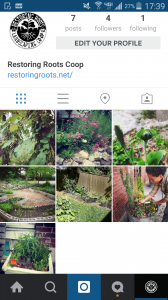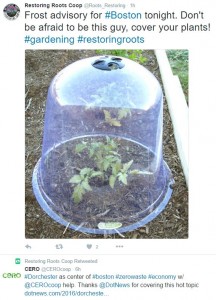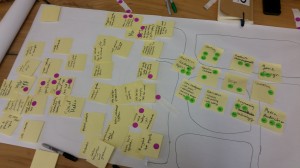After last week’s class and a discussion about our project with Sasha and Evan, we decided to narrow down our idea to create a gardening app that could be used as an educational tool and personalized garden manager. Our ever-updating canvas can be found here.
With a clearer picture of what we want to create, we conducted interviews targeting landscapers, arborists, clients or members of Restoring Roots, and homeowners/rental property owners. We developed different questions based on the interviewee’s occupation or relationship with Restoring Roots. Here’s our sample script for a land or property owner:
Have you ever had professional landscaping/permaculture/design services performed?
Have you ever had your landscaping redone or made any changes since the original design?
What might prevent you from hiring a professional for these services?
Have you ever grown your own food? Do you enjoy seeing wildlife in the city?
How do you relate to outdoor spaces around your home or in your neighborhood?
Have you ever used an app or game about gardening or plant-related things? Plants vs zombies? Leafsnap? Farmville? Etc.
If you have kids, how important is it that your children grow up with a connection to the outdoors and gardening?
How do you keep track of what plants are in your garden?
How do you access information about those plants?
What is the main obstacle to you growing and using plants in the space that is available to you?
What do you know about permaculture? What is your level of interest in it?
Andreas interviewed a property owner and mother living in Cambridge. She had hired a landscaper twice but found it expensive, so she wanted to do it herself and keeps a vegetable garden in the backyard with space for her kids and dog to play. She had never used a gardening app but takes pictures of her flowers and plants with her phone. Additionally, she recorded gardening information found online in a notebook and was interested in learning more about permaculture and rain catchment.
A father from Somerville renting his property used a landscaper to design and manage his yard, citing lack of knowledge and time as preventing him from growing plants himself. He did not do anything formal to keep track of his yard, simply using visual cues to assess his plants. He was somewhat interested in learning more about permaculture. As a parent, he highly valued his children’s connection to the outdoors.
Bridget interviewed homeowners in Amherst. They live in a new neighborhood where almost all of the houses had professional landscaping. They noted that most houses started out with similarly landscaped backyards, but over time the homeowners changed their properties so that now everyone has a different and distinct yard.
Their neighborhood is near a protected wetland, so their landscaper advised against a lawn with many chemicals in the grass – this means their front yard is filled with weeds and they cannot kill gypsy moths with pesticides. But not all landscapers are conscientious about the nearby nature, so some of their neighbors have lawns filled with chemicals. The homeowners contacted the town about the toxic yards and suspect that the landscaper just comes by at night and has not changed his practices.
The interviews revealed how homeowners use landscaping to achieve a goal – such as to increase privacy from neighbors or make a backyard kid-friendly or colorful in all seasons. The cost of landscaping or gardening can be high and some homeowners tried doing the work themselves, while others found they lacked the knowledge necessary to design their own projects. Almost all interviewees had professional landscaping done, to varying degrees of satisfaction. All cited the cost of landscaping as a deterrent from seeking professional services.
We still have more interview transcripts to complete and more interviews to conduct (especially targeting landscapers and Restoring Roots’ clients) but just from the information we collected this week we have lots to think about!


